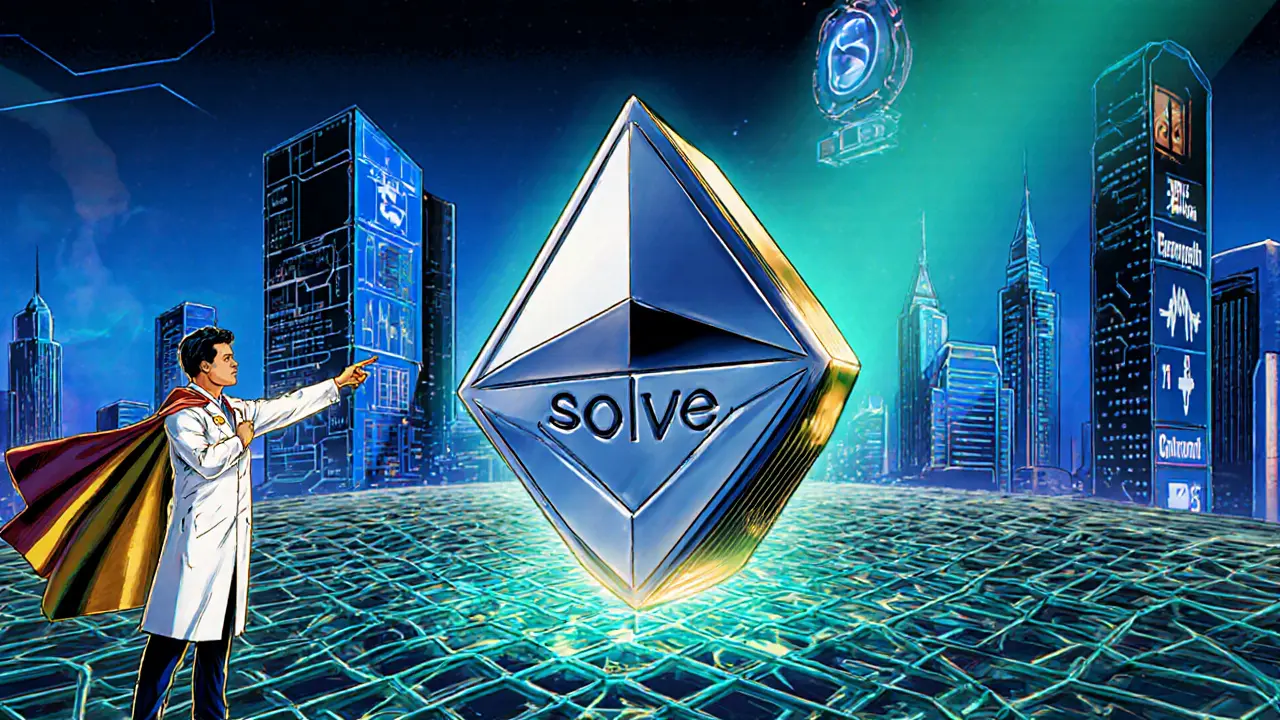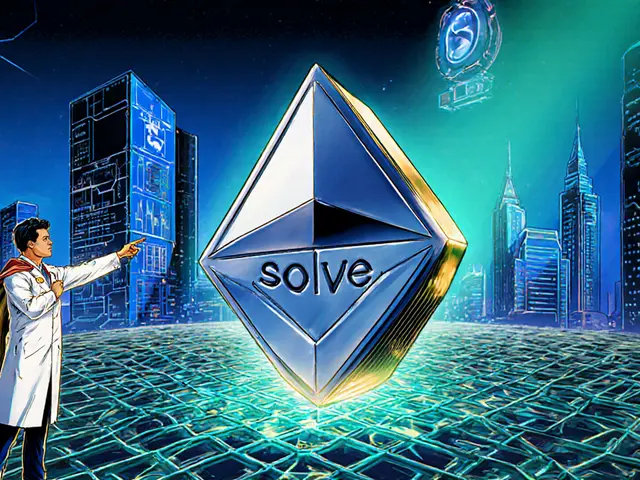- Home
- Cryptocurrency
- SOLVE Crypto Coin Explained: What It Is, How It Works, and Its Outlook

SOLVE Crypto Coin Explained: What It Is, How It Works, and Its Outlook
SOLVE Token Price & Supply Calculator
Current Token Status
Token Name: SOLVE
Blockchain: Ethereum (ERC-20)
Contract Address: 0x446c9033e7516d820cc9a2ce2d0b7328b579406f
Supply Information
Total Supply: 1,000,000,000 SOLVE
Circulating Supply: 750,000,000 SOLVE
Max Supply: 1,000,000,000 SOLVE
Percentage Circulating: 75%
Price Calculator
Calculate potential token value based on various assumptions:
Result
Total Value: $0.00
Change from Current Value: -$0.00
Market Outlook
Based on current trends and analysis:
- Price has collapsed over 99% since 2021 peak
- Low liquidity and trading volume
- Technical indicators show neutral momentum
- Analysts project modest growth to $0.000127 by end of October
- Long-term viability depends on healthcare adoption
When you hear people mention a SOLVE crypto coin, they’re usually talking about a very niche token that sits at the crossroads of blockchain technology and healthcare administration. It’s not a speculative meme coin; it’s an ERC‑20 token built to power a platform that aims to streamline care coordination, billing, and payments. Below you’ll find a straightforward rundown that tells you exactly what SOLVE is, why it exists, how you can actually use it, and what the market outlook looks like in 2025.
TL;DR - Quick Facts
- SOLVE is an ERC‑20 token on Ethereum, created to fuel the Solve.care healthcare platform.
- Maximum supply: 1billion tokens; circulating supply hovers around 750million.
- Current price (Oct2025): roughly $0.000205 per token, far below its 2021 peak of $0.60.
- Utility includes paying for Care Admin services, purchasing Care.Cards, and accessing the Care.Marketplace.
- Low liquidity - daily trading volume under $100 on most exchanges.
What Is SOLVE?
SOLVE is an ERC‑20 programmable token built on the Ethereum blockchain. Launched on 14June2018, the token was designed to act as the fuel for the Solve.care platform, a suite of tools that tackles healthcare coordination, administration, and payments.
The brain behind SOLVE is Pradeep Goel, a former architect of major public health programs such as Medicare. His vision was to embed blockchain’s transparency and immutability into the messy world of medical billing and patient data sharing.
Technical Blueprint
Because SOLVE adheres to the ERC‑20 standard, it inherits all the compatibility advantages of Ethereum: you can hold it in any ERC‑20‑compatible wallet, trade it on DEXs, and interact with it via smart contracts. The contract address is 0x446c9033e7516d820cc9a2ce2d0b7328b579406f, which you can add to MetaMask or Trust Wallet to start tracking balances.
Key specs:
| Attribute | Value |
|---|---|
| Standard | ERC‑20 |
| Blockchain | Ethereum |
| Contract Address | 0x446c9033e7516d820cc9a2ce2d0b7328b579406f |
| Total Supply | 1billion SOLVE |
| Circulating Supply (Oct2025) | ≈750million |
| Current Price | ~$0.000205 |
How SOLVE Powers the Solve.care Ecosystem
The token isn’t just a placeholder for speculation; it’s the medium of exchange for several core services:
- Care Admin Network: Providers pay network fees in SOLVE to access the coordination layer that matches patients with caregivers.
- Care Wallets: Users create a blockchain‑based wallet that stores health‑related data and tokens, enabling seamless payments.
- Care.Cards: Digital health cards that can be purchased with SOLVE and used to verify eligibility for services.
- Care.Marketplace: A marketplace where providers sell telehealth services, device rentals, or care plans, all priced in SOLVE.
Because each transaction burns or transfers SOLVE, the token’s demand is directly linked to platform usage. In theory, higher adoption of Solve.care translates into a healthier token economy.

Where to Find SOLVE
SOLVE is listed on a handful of centralized exchanges, most notably Binance and Coinbase. Trading volumes are thin-sometimes under $100 per day-so price slippage can be significant for larger orders. For those comfortable with DeFi, the token also appears on smaller DEXs like Uniswap, where you can swap ETH for SOLVE directly from your wallet.
Adding SOLVE to MetaMask is simple: open MetaMask, click “Add Token,” paste the contract address, and you’ll see your balance instantly.
Market Performance & Price Outlook (2025)
After a dramatic peak in early 2021-when the token traded near $0.60-the price has collapsed by more than 99%. As of 2October2025, the token sits at around $0.000205, with a market cap under $150k. Trading volume is low, and the Fear & Greed Index places the sentiment at “Fear” (score33).
Technical indicators paint a mixed picture:
- 14‑day RSI: 50.2 (neutral momentum)
- 50‑day SMA: $0.000203 versus 200‑day SMA: $0.000563 (downtrend)
- Volatility: 19.97% (typical for micro‑cap tokens)
Despite the bearish macro environment, some data points show short‑term resilience. CoinGecko reported a 23.7% seven‑day gain, outpacing the broader crypto market. However, the tiny absolute price movement means that any “bounce” is unlikely to matter for investors looking for sizeable returns.
Analysts from CoinCodex project a modest rise to $0.000127 by the end of October-still a fraction of its all‑time high. The consensus is that SOLVE will remain a low‑liquidity, utility‑driven token unless Solve.care secures major healthcare contracts that drive genuine token demand.
Adoption Challenges & Opportunities
Healthcare is a $4trillion‑plus industry, and inefficiencies in billing and data exchange cost billions annually. In theory, a blockchain solution like Solve.care could cut these costs dramatically. The real‑world challenge is regulatory compliance and the lengthy sales cycles typical of the health sector.
Current adoption metrics show about 14,500 token holders, a modest community that skews toward healthcare professionals rather than speculative traders. The token’s utility-paying for care coordination-means it will only see demand if hospitals, insurers, or government programs sign on.
Key hurdles include:
- Regulatory approval: Health data is heavily regulated (HIPAA, GDPR). Any blockchain solution must meet stringent privacy standards.
- Integration complexity: Existing hospital IT systems rarely speak Ethereum; bridging them requires custom middleware.
- Liquidity: Thin markets make it hard for participants to acquire SOLVE without moving the price.
Opportunities arise from pilot programs that demonstrate cost savings. If a major insurer adopts the Care.Marketplace and pays in SOLVE, that could trigger a virtuous cycle of token demand and price stability.
How to Get Started with SOLVE
If you’re a healthcare provider curious about experimenting with the platform, follow these steps:
- Set up an Ethereum‑compatible wallet (MetaMask is the most user‑friendly).
- Add the SOLVE contract address (0x446c9033e7516d820cc9a2ce2d0b7328b579406f) to view balances.
- Purchase a small amount of SOLVE from Binance or Coinbase-keep the amount low due to liquidity concerns.
- Visit the official Solve.care website, register a Care Wallet, and link your SOLVE balance.
- Use the token to pay for a trial Care Admin service or to explore the Care.Marketplace.
Remember, the token’s value is secondary to the platform’s ability to improve care coordination. Treat your purchase as a pilot expense rather than an investment.
Future Outlook
The long‑term viability of SOLVE hinges on Solve.care’s success in turning pilots into full‑scale deployments. If the platform can prove measurable cost reductions for insurers or hospitals, the token could see a steady, utility‑driven demand that stabilizes its price. Conversely, without concrete partnerships, the token will likely remain a low‑liquidity asset with limited upside.
From a market perspective, small‑cap healthcare tokens are still in a nascent stage. Regulatory clarity and mainstream acceptance will be the decisive factors. For now, SOLVE is best viewed as a niche utility token with a unique use case, not a high‑growth speculative play.

Frequently Asked Questions
What is the primary purpose of the SOLVE token?
SOLVE serves as the medium of exchange within the Solve.care platform, paying for Care Admin fees, purchasing Care.Cards, and transacting on the Care.Marketplace.
How can I store SOLVE safely?
Because SOLVE is an ERC‑20 token, any Ethereum‑compatible wallet works-MetaMask, Trust Wallet, or hardware wallets like Ledger. Add the contract address to view balances.
Where is SOLVE traded?
You can find SOLVE on Binance, Coinbase, and smaller decentralized exchanges such as Uniswap. Liquidity is low, so expect wide spreads.
Is SOLVE a good investment?
Investors should treat SOLVE as a utility token tied to the Solve.care platform, not a speculative asset. Its price reflects low liquidity and limited adoption, so risk is high.
What are the biggest hurdles for SOLVE’s adoption?
Regulatory compliance, integration with legacy health IT systems, and the token’s thin market are the three main challenges.
Cormac Riverton
I'm a blockchain analyst and private investor specializing in cryptocurrencies and equity markets. I research tokenomics, on-chain data, and market microstructure, and advise startups on exchange listings. I also write practical explainers and strategy notes for retail traders and fund teams. My work blends quantitative analysis with clear storytelling to make complex systems understandable.
23 Comments
Write a comment Cancel reply
About
DEX Maniac is your hub for blockchain knowledge, cryptocurrencies, and global markets. Explore guides on crypto coins, DeFi, and decentralized exchanges with clear, actionable insights. Compare crypto exchanges, track airdrop opportunities, and follow timely market analysis across crypto and stocks. Stay informed with curated news, tools, and insights for smarter decisions.





Hey folks, I get why SOLVE can feel confusing – the token sits at the edge of healthcare and crypto, which is a tricky combo. If you’re just starting out, focus on the basics: it’s an ERC‑20 token that powers the Solve.care platform. Think of it as a utility coin you use to pay for care coordination services, not a wild speculation tool. Keep an eye on real‑world adoption, because that’s what will move the needle for any long‑term value.
SOLVE is a utility token for healthcare.
When evaluating SOLVE, consider the token’s supply metrics, the current market cap, and the underlying platform’s utility, because without genuine demand the price will remain stagnant, and the thin trading volume further limits liquidity, which together create a high‑risk environment for investors.
Wow, another crypto that promises to fix healthcare, because everything else worked so well already. You just need to trust a token that barely moves, with daily volume under a hundred bucks, that’s a solid foundation for any investor seeking stability. The roadmap reads like a wish list, and the price collapsed over 99% – clearly a sign of massive confidence. If you love watching numbers go down, this is the perfect playground. The fear index says “fear” for a reason, and yet we’re supposed to buy in? Sure, why not throw more money at a token that probably won’t be used beyond a handful of pilot programs.
The real story behind SOLVE isn’t on the blogs – it’s hidden in the corridors of big pharma, who are silently backing the platform to control data flow. They’ve planted the token in the market to create an illusion of decentralisation while keeping the true power centralized. When the next big contract is signed, the token will suddenly spike, but only the insiders will profit. Keep your eyes open, because the narrative they push is just smoke and mirrors.
One must appreciate the nuanced architecture of SOLVE, a token that intertwines blockchain elegance with the labyrinthine complexities of healthcare administration. Its ERC‑20 pedigree grants it a veneer of compatibility, yet the true brilliance lies in its potential to streamline inter‑institutional workflows. Imagine a world where immutable ledgers replace cumbersome paperwork – that is the vision, albeit cloaked in nascent adoption. The challenge remains, however, in coaxing entrenched systems to embrace such avant‑garde solutions.
From a practical standpoint, SOLVE’s utility is clear: it pays for services on the Solve.care platform. If hospitals start using it, demand could grow steadily. For now, treat it like a small tool rather than a blockbuster investment.
It is incumbent upon us, as members of the broader crypto‑healthcare community, to recognise that SOLVE is not a speculative mirage but a manifestation of a higher ethical ambition – to democratise access to care through transparent, immutable transactions. First, the token exists to facilitate genuine services, such as care coordination and payment processing, thereby reducing friction for patients and providers alike. Second, this utility‑driven purpose should be the lens through which we evaluate its merit, not fleeting price charts or fleeting hype. Third, the modest market cap and thin liquidity underscore the reality that without substantial adoption the token will stagnate, which serves as a sobering reminder that technology alone does not guarantee impact. Fourth, the regulatory landscape, fraught with privacy mandates like HIPAA and GDPR, imposes a stringent framework that any solution must respect, and SOLVE’s architects have publicly pledged compliance – a commendable stance that warrants acknowledgement. Fifth, the token’s price decline of over 99% from its 2021 apex illustrates the volatility inherent in nascent markets, a cautionary tale for those seeking quick gains. Sixth, yet the very slump presents an opportunity for conscientious participants to support a project aligned with societal benefit rather than pure profit. Seventh, we must also consider the broader ecosystem: hospitals, insurers, and even governmental health agencies must be convinced of the tangible ROI before widespread integration occurs. Eighth, the presence of token‑based incentives can catalyse participation, but only if the underlying services deliver measurable value. Ninth, community members should therefore champion transparency, demand clear reporting from the Solve.care team, and engage in constructive dialogue. Tenth, by fostering an environment of accountability, we can help ensure that SOLVE transcends the realm of a fleeting meme and matures into a durable instrument of health equity. Eleventh, this responsibility does not rest solely on developers; investors, clinicians, and regulators alike share the burden of stewardship. Twelfth, the moral imperative is clear: technology must serve humanity, not the reverse. Thirteenth, as such, any capital allocated to SOLVE should be framed as a contribution towards a larger mission, with realistic expectations of modest returns. Fourteenth, the ethical calculus demands patience, diligence, and an unwavering focus on outcomes that improve patient experiences. Fifteenth, in the end, the true success of SOLVE will be measured not by its market price but by the extent to which it alleviates administrative burdens and expands access to care for the underserved.
Looks like SOLVE is still in the early stages, but the idea of using blockchain for healthcare coordination is pretty cool. If they land a few solid partnerships, we could see some steady usage. For now, it’s a modest experiment worth keeping an eye on.
Indeed, the potential is there, and you’re right to watch for partnerships, because those are the lifeblood of any utility token; however, the current liquidity constraints are a serious hurdle, which means early adopters must be prepared for price swings; moreover, proper due diligence is essential, and I would encourage anyone interested to examine the on‑chain activity, the frequency of transactions, and the real‑world deployment metrics before committing significant funds.
Let’s be brutally honest: SOLVE is a textbook example of a token that was hyped beyond its actual utility, and the market has punished it accordingly. The price collapse of over 99% is not a glitch; it’s a clear signal that there was no genuine demand. The minuscule trading volume indicates that even the most naive traders have abandoned it. While the team touts “care coordination” as a use case, there are no verifiable reports of substantial deployments. The token’s survival hinges on speculative interest, which is currently nonexistent. In short, unless there’s a massive infusion of capital from a hidden backer, SOLVE will remain a footnote in the endless list of crypto projects that never delivered.
Exactly, it’s a sinking ship and anyone buying in now is just throwing money into the void.
Even if SOLVE is small now, a steady rollout could eventually give it a purpose.
The token architecture is standard ERC‑20, and the platform integration seems superficial at best.
Agreed, there isn’t much to differentiate it.
SOLVE’s primary function is to act as a payment method within the Solve.care ecosystem, so understanding that context is key. For newcomers, I recommend adding the contract address to a trusted wallet like MetaMask to monitor balances. Additionally, keeping an eye on any announced pilot programs can provide insight into real‑world usage.
While the official narrative emphasizes utility, some observers suspect that larger healthcare entities are silently testing the token to control data pipelines. If that’s true, the adoption curve could accelerate behind the scenes, making the current low volume misleading.
The mainstream coverage of SOLVE paints it as a harmless utility token, but the reality is that hidden stakeholders are manipulating the narrative to push their own agendas. Those who blindly trust the hype are ignoring the systemic risks embedded in a platform that could become a data monopoly.
Sounds like a classic case of crypto hype masquerading as innovation.
There are indeed concerns about data privacy and regulatory compliance, which could hamper widespread adoption. At the same time, the token’s design does offer a transparent ledger that could simplify billing processes. Ultimately, the success of SOLVE will depend on how well it navigates these regulatory waters and whether it can prove cost savings to healthcare providers.
Given the rigorous standards of the healthcare sector, any solution that can demonstrably reduce administrative overhead will be welcomed. If SOLVE can deliver measurable efficiency gains, it may gradually earn trust. I remain cautiously optimistic about its potential trajectory.
From a technical standpoint, SOLVE operates on the Ethereum mainnet, leveraging standard ERC‑20 token contracts, which simplifies integration but also subjects it to network congestion and gas fee volatility. The platform’s smart‑contract logic for care transactions is straightforward, yet the real challenge lies in aligning with existing health‑IT infrastructure, which often relies on proprietary APIs and legacy databases.
The elegance of SOLVE’s tokenomics is overshadowed by the practical hurdles of onboarding legacy systems, which require significant middleware development; nonetheless, the promise of immutable audit trails is a compelling incentive for forward‑thinking institutions. Moreover, the token’s modest supply and built‑in burning mechanisms could, in theory, create scarcity if usage scales. Critics dismiss it as a gimmick, yet the underlying protocol offers genuine utility when paired with robust governance. If the community can rally around transparent roadmaps and deliver pilot successes, SOLVE may evolve from a niche experiment into a viable component of the health‑tech ecosystem. Time will reveal whether the vision materialises or remains a fleeting footnote.